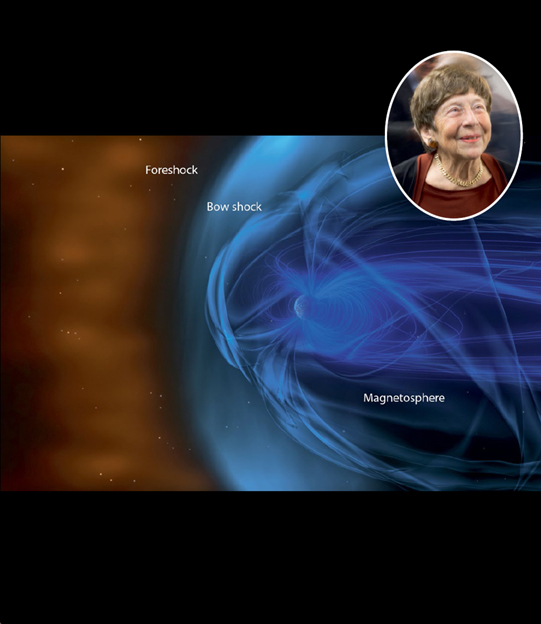1984
The Oscillating Magnetosphere
Margaret Kivelson (b. 1928)
Earth is surrounded by a protective “bubble” of magnetic fields called the magnetosphere. Our planet’s magnetism is generated deep in its interior, as Earth’s partially molten, metallic iron core spins on its axis. Like the invisible field lines from an iron bar magnet, Earth’s field lines extend far past the surface. And like the water in front of a fast-moving boat, Earth’s magnetic field lines are compressed into a bow wave where the strong “flow” of high-energy particles streaming out of the Sun (the solar wind) plows into our magnetosphere.
The basic outline and properties of the magnetosphere have been studied since the seventeenth century, through laboratory experiments with magnets as well as long-term observations of auroras in the polar regions, which are one manifestation of our magnetosphere’s interactions with the solar wind. However, only with the use of satellites that have been directly probing the magnetosphere since the late 1950s have we really begun to understand this critical part of Earth’s system.
Among the leading magnetosphere researchers is American space physicist Margaret (“Margie”) Kivelson, who began studying magnetic fields in the late 1950s, and has since been involved in a number of space satellite missions studying the magnetosphere. Kivelson led a key research paper in 1984 that discovered the presence of large ultra-low-frequency waves in the magnetosphere. Apparently, these waves are created by the pulsating solar wind crashing into the outer—most tenuous—layers of the magnetosphere. Like waves breaking on a beach, these huge magnetic waves help accelerate and transport particles from the solar wind and outer magnetosphere onto the “shores” of the inner magnetosphere, where they can be studied in detail.
Kivelson, who has won numerous prestigious honors and awards for her work, also uses her expertise in terrestrial magnetism to study the magnetic fields of the giant planets and their moons. Indeed, she led the team that discovered that the solar system’s largest moon, Ganymede, has a magnetic field of its own (and is the only moon with one), and that Jupiter’s magnetic fields provide strong evidence for the existence of a subsurface liquid ocean on its moon Europa.
SEE ALSO Earth’s Core Forms (c. 4.54 Billion BCE), Earth’s Mantle and Magma Ocean (c. 4.5 Billion BCE), Women in Earth Science (1896), The Inner Core (1936), Earth’s Radiation Belts (1958), Extremophiles (1967), Earth Science Satellites (1972), Earth’s Core Solidifies (~2–3 Billion)
Main image: Illustrative depiction of the Earth’s magnetosphere (blue lines), which “holds off” the onrushing solar wind (orange, at left), protecting life on our planet from much of that high-intensity radiation. Inset: Margie Kivelson in 2017.
